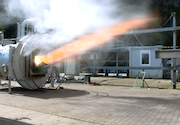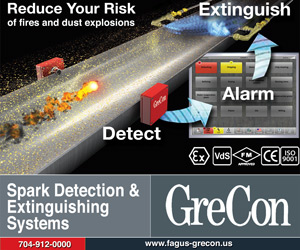| |
| |
 |
 |
| |
 |
|
@{mv_date_MMM d, yyyy}@ |
|
| |
 Fibre piles contain materials that consolidate and pack together. The densities within the material leads to microbial growth and biological activity and can cause fibre piles to self-heat over time, triggering combustion within the pile(s). The BC Forest Safety Council shares some fibre pile management best practices.
» Read more...
Fibre piles contain materials that consolidate and pack together. The densities within the material leads to microbial growth and biological activity and can cause fibre piles to self-heat over time, triggering combustion within the pile(s). The BC Forest Safety Council shares some fibre pile management best practices.
» Read more...
Jeffrey Nichols, managing partner at Industrial Fire Prevention, LLC, shares his experience helping wood processing plants improve their safety and prevent fires and explosions.
» Read more...
For the fifth year in a row, Dust Safety Science has compiled and analyzed combustible dust incidents from around the world. As of Dec. 31, 2020, almost 1,000 incidents were recorded, along with a detailed analysis of the materials, industries and equipment involved.
» Read more...
|
| |
 |
 |
| |
|
| |

This updated edition of NFPA 652 is essential to manage the dust-related fire, flash fire, and explosion hazards in industries that use dust collection and handling equipment, or that have processes that may generate combustible dust.
Experts in fire and explosion safety for areas with combustible dust worked together to make NFPA 652 an even more effective tool for avoiding these destructive and deadly events, and is a go-to source for the information necessary to help handle combustible dust safely in any industry, anywhere around the globe. NFPA 652 serves the chemical, wood processing, metals, and agricultural industries. This and other NFPA standards are available in Canada from Annex Bookstore.
>> Learn more |
| |
|
| |
 It’s no secret that risk accompanies wood processing. Wood burns. Dry wood burns easily. Wood dust can explode. Biomass Engineering & Equipment's Joel Dulin shares what you need to know about NFPA 652 and 664 to prevent fires and combustible dust explosions.
» Learn more...
It’s no secret that risk accompanies wood processing. Wood burns. Dry wood burns easily. Wood dust can explode. Biomass Engineering & Equipment's Joel Dulin shares what you need to know about NFPA 652 and 664 to prevent fires and combustible dust explosions.
» Learn more... |
| |
 When handling explosive dusts such as wood or grain, mitigating the possibility of an explosion event is only one part of keeping a facility and its occupants safe. It’s equally important to plan for what will happen when an explosive incident takes place, not if it does.
» Learn more...
When handling explosive dusts such as wood or grain, mitigating the possibility of an explosion event is only one part of keeping a facility and its occupants safe. It’s equally important to plan for what will happen when an explosive incident takes place, not if it does.
» Learn more... |
| |
|
| |
Between May and September 1919, four grain elevators in four different North American cities exploded in similar incidents, killing 70 people and injuring 60 more. Although these incidents occurred over 100 years ago, the answers are still relevant today, especially with the parallels between the Spanish Flu and COVID-19.
» Read more...
|
A dust hazard analysis (DHA) is a systematic review and assessment of a process and/or facility led by someone with knowledge and experience in understanding and identifying combustible dust hazards. Rembe’s Jeramy Slaunwhite explains what you need to know about DHAs.
» Read more...
|
|
Data from Fike Corporation’s Remote Testing Facility proves explosion isolation flap valves are not always tested under real-world conditions, and as a result, many flap valves on the market won’t function as certified.
» Read more...
| | |
|
| |

|
| |
| |









